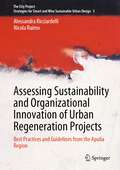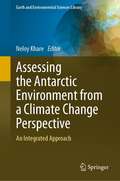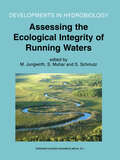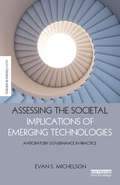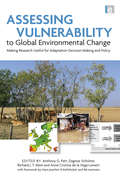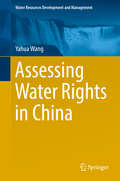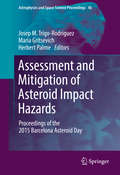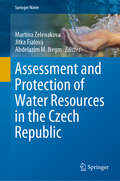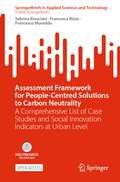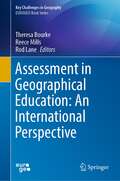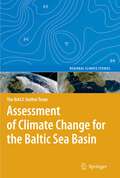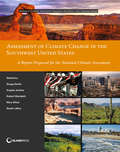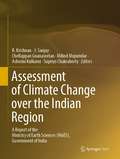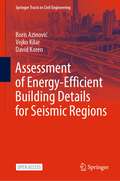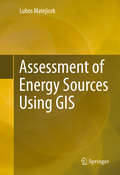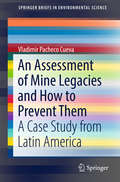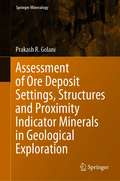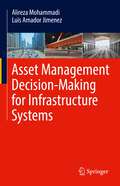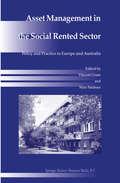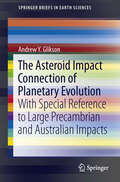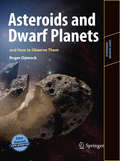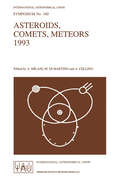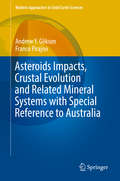- Table View
- List View
Assessing Sustainability and Organizational Innovation of Urban Regeneration Projects: Best Practices and Guidelines from the Apulia Region (The City Project #3)
by Alessandra Ricciardelli Nicola RaimoThis book offers the first comprehensive report on the topic of organizational innovation and sustainability of urban regeneration from the public manager's perspective. Starting from a rich set of case studies on urban regeneration from the region of Apulia, in Italy, it develops a framework for measuring their sustainability performance. It proposes the use of indicators related to different aspects of the urban regeneration process, including the participations of stakeholders; land use and buildings; economy and jobs; transportation; environmental pollution; energy use; waste management; as well as open spaces and wildlife. This book offers extensive information to graduate students and researchers, and to authorities, developers, investors and stakeholders alike, involved in the design, planning and management, and sustainable development of urban spaces. It is expected to foster a better understanding of the level of organizational innovation and sustainability of urban regeneration projects and the role of governing bodies in their implementation.
Assessing the Antarctic Environment from a Climate Change Perspective: An Integrated Approach (Earth and Environmental Sciences Library)
by Neloy KhareThe present book covers diversified contributions addressing the impact of climate change on the Antarctic environment. It covers the reconstruction of environmental changes using different proxies. The chapters focus on the glacial history, glacial geomorphology, sedimentology, and geochemistry of Antarctic region. Furthermore, the Cenozoic evolution of the Antarctic ice sheet is discussed along with a Scientometrics analysis of climate change research. The book serves as a useful reference for researchers who are fascinated by the polar region and environmental research.
Assessing the Ecological Integrity of Running Waters: Proceedings of the International Conference, held in Vienna, Austria, 9–11 November 1998 (Developments in Hydrobiology #149)
by M. Jungwirth S. Muhar S. SchmutzThe assessment of the ecological integrity of running waters is a prerequisite to an understanding of the effects of human alterations. The evaluation of degradation processes provides key information on how to avoid further negative impacts. The success of future conservation, mitigation and restoration activities will rely on sound assessment methodologies and their ecological relevance and applicability. Assessment methodologies are therefore an integral part of sustainable river management. This book synthesizes and discusses state-of-the-art experiences in assessment methodologies. Including the latest knowledge on structures, processes and functions of running waters as a fundamental basis for developing adequate assessment methods, the book focuses on method development, application, and in particular on integrated assessment methods. This book is directed at scientists and managers with the aim of more effective preservation, restoration and maintenance of the ecological integrity of running water ecosystems.
Assessing the Societal Implications of Emerging Technologies: Anticipatory governance in practice (The Earthscan Science in Society Series)
by Evan S. MichelsonA growing problem of interest in the field of science and technology policy is that the next generation of innovations is arriving at an accelerating rate, and the governance system is struggling to catch up. Current approaches and institutions for effective technology assessment are ill suited and poorly designed to proactively address the multidimensional, interconnected societal impacts of science and technology advancements that are already taking place and expected to continue over the course of the 21st century. This book offers tangible insights into the strategies deployed by well-known, high-profile organizations involved in anticipating the various societal and policy implications of nanotechnology and synthetic biology. It focuses predominantly on an examination of the practices adopted by the often-cited and uniquely positioned Project on Emerging Nanotechnologies in the United States, as well as being informed by comparisons with a range of institutions also interested in embedding forward-looking perspectives in their respective area of innovation. The book lays out one of the first actionable roadmaps that other interested stakeholders can follow when working toward institutionalizing anticipatory governance practices throughout the policymaking process.
Assessing the Societal Implications of Emerging Technologies: Anticipatory governance in practice (The Earthscan Science in Society Series)
by Evan S. MichelsonA growing problem of interest in the field of science and technology policy is that the next generation of innovations is arriving at an accelerating rate, and the governance system is struggling to catch up. Current approaches and institutions for effective technology assessment are ill suited and poorly designed to proactively address the multidimensional, interconnected societal impacts of science and technology advancements that are already taking place and expected to continue over the course of the 21st century. This book offers tangible insights into the strategies deployed by well-known, high-profile organizations involved in anticipating the various societal and policy implications of nanotechnology and synthetic biology. It focuses predominantly on an examination of the practices adopted by the often-cited and uniquely positioned Project on Emerging Nanotechnologies in the United States, as well as being informed by comparisons with a range of institutions also interested in embedding forward-looking perspectives in their respective area of innovation. The book lays out one of the first actionable roadmaps that other interested stakeholders can follow when working toward institutionalizing anticipatory governance practices throughout the policymaking process.
Assessing Vulnerability to Global Environmental Change: Making Research Useful for Adaptation Decision Making and Policy
by Richard J. Klein Anthony G. PattAssessing the vulnerability of human populations to global environmental change, particularly climate change, is now the main imperative of research and international action. However, much of the research into vulnerability is not designed to feed directly into decision making and policy, creating a gap between the knowledge created by researchers and what is required by decision makers. This book seeks to rectify this problem and bridge the gap. It discusses vulnerability as the central theme and brings together many different applications from disaster studies, climate change impact studies and several other fields and provides the most comprehensive synthesis of definitions, theories, formalization and applications to date, illustrated with examples from different disciplines, regions and periods, and from local through to regional, national and international levels. Case study topics cover sea level rise, vulnerability to changes in ecosystem services, assessing the vulnerability of human health and 'double exposure' to climate change and trade liberalization amongst other issues. Research outcomes stress that science-policy dialogues must be transparent to be effective and concentrate on a mutual understanding of the concepts used. A key research finding is that the most useful information for decision makers is that which shows the separate causes and drivers of vulnerability, rather than presenting vulnerability in an aggregated form. The book concludes with a unifying framework for analysing integrated methodologies of vulnerability assessment and guiding how research and policy can be linked to reduce vulnerability.
Assessing Vulnerability to Global Environmental Change: Making Research Useful for Adaptation Decision Making and Policy
by Richard J. Klein Anthony G. PattAssessing the vulnerability of human populations to global environmental change, particularly climate change, is now the main imperative of research and international action. However, much of the research into vulnerability is not designed to feed directly into decision making and policy, creating a gap between the knowledge created by researchers and what is required by decision makers. This book seeks to rectify this problem and bridge the gap. It discusses vulnerability as the central theme and brings together many different applications from disaster studies, climate change impact studies and several other fields and provides the most comprehensive synthesis of definitions, theories, formalization and applications to date, illustrated with examples from different disciplines, regions and periods, and from local through to regional, national and international levels. Case study topics cover sea level rise, vulnerability to changes in ecosystem services, assessing the vulnerability of human health and 'double exposure' to climate change and trade liberalization amongst other issues. Research outcomes stress that science-policy dialogues must be transparent to be effective and concentrate on a mutual understanding of the concepts used. A key research finding is that the most useful information for decision makers is that which shows the separate causes and drivers of vulnerability, rather than presenting vulnerability in an aggregated form. The book concludes with a unifying framework for analysing integrated methodologies of vulnerability assessment and guiding how research and policy can be linked to reduce vulnerability.
Assessing Water Rights in China (Water Resources Development and Management)
by Yahua WangThis book presents a model for describing the hierarchical concept of China’s water rights structure, one which takes into account pioneering theories on natural resources and environmental institutional economics. It highlights the basic theory of water rights, with a view to helping Chinese policymakers acquire a deeper understanding of water rights and the need for a reform program in the long-term development of water-poor China. To do so, it draws on three main sources: Cheung SNS’s “Economic Explanation”, Douglas C. North’s “New Economic History” and Ray Huang’s “Macro History”.The book makes two essential contributions: it elaborates the hierarchical water governance structure in China, which originated in the Qin Dynasty that unified the country 2000 years ago and has been employed without interruption ever since; further, it constructs a choice model for water governance structures and advances the logic of making structural choices with minimum transaction costs under constraint conditions, while also explaining the inherent nature of China’s choice for the hierarchical structure from the perspectives of management cost and cooperation cost. As such, the book enriches and builds on the theories of the “water governance” school represented by Karl Marx, Karl Wittfogel and Ray Huang, laying the foundation for the further study of water rights theory in contemporary China.
Assessment and Mitigation of Asteroid Impact Hazards: Proceedings of the 2015 Barcelona Asteroid Day (Astrophysics and Space Science Proceedings #46)
by Josep M. Trigo-Rodríguez Maria Gritsevich Herbert PalmeThis volume is a compilation of the research presented at the International Asteroid Day workshop which was celebrated at Barcelona on June 30th, 2015. The proceedings discuss the beginning of a new era in the study and exploration of the solar system’s minor bodies. International Asteroid Day commemorates the Tunguska event of June 30th, 1908. The workshop’s goal was to promote the importance of dealing proactively with impact hazards from space. Multidisciplinary experts contributed to this discussion by describing the nature of comets and asteroids along with their offspring, meteoroids. New missions to return material samples of asteroids back to Earth such as Osiris-REx and Hayabusa 2, as well as projects like AIM and DART which will test impact deflection techniques for Potentially Hazardous Asteroids encounters were also covered. The proceedings include both an outreach level to popularize impact hazards and a scientific character which covers the latest knowledge on these topics, as well as offering proposals of promising new techniques that will help gain new insights of the properties of these challenging bodies by studying meteoroids and meteorites. Asteroids, comets, meteoroids and meteorites are introduced with descriptions of their nature, origin, and solar system pathways.
Assessment and Protection of Water Resources in the Czech Republic (Springer Water)
by Martina Zelenakova Jitka Fialová Abdelazim M. NegmThis book gathers technical and scientific contributions from leading researchers, academics, and lecturers, focusing on water management, water pollution and water structures in the Czech Republic. It discusses a variety of water resources management issues, from stormwater management in urban areas, water quantity, hydraulics structures and hydrodynamic modeling, to flood protection, presenting state-of-the-art developments for addressing a range of problems. Edited and authored by pioneers in the field who have been at the cutting edge of water management development in the Czech Republic, this book is of interest to environmental professionals, including scientists and policymakers both in the Czech Republic and around the globe.
Assessment Framework for People-Centred Solutions to Carbon Neutrality: A Comprehensive List of Case Studies and Social Innovation Indicators at Urban Level (SpringerBriefs in Applied Sciences and Technology)
by Sabrina Bresciani Francesca Rizzo Francesco MuredduThis open access book presents a catalogue of over one thousand indicators which can be used by cities' public administrators to monitor and evaluate social innovation action plans to support people-centred, collaborative or co-designed solutions to lower carbon emissions. Indicators are clustered according to a framework of social innovation solutions for climate neutrality at city level, developed by merging top-down academic knowledge with bottom-up pragmatic case studies. There is currently limited guidance on how to embed social innovations in their cities’ action plans with the aim of reaching climate neutrality, and on how to assess the progress and impacts of such people-centred projects in cities. The book addresses this gap and is thus relevant for scholars in the field of policy-making and design, as well as cities’ transition teams, policymakers and consultants. Based on the work developed within the EU-funded project NetZeroCities, intervention logics are provided for each of the ten categories of action, with related indicators clustered by category and evaluation criteria (effectiveness, efficiency, relevance, replicability, and scalability). Guidelines to implement the framework support city administrators in defining steps they need to follow to apply the indicators to their local case, making social innovation a crucial lever for accelerating systemic transformation.
Assessment in Geographical Education: An International Perspective (Key Challenges in Geography)
by Theresa Bourke Reece Mills Rod LaneIn recent years there has been increased attention paid to the importance of assessment in Geographical Education, the chosen subject for this book. Assessment is an important tool for collecting information about student learning and for providing timely data to inform key stakeholders including students, teachers, parents and policymakers. To be effective, assessment needs to be valid, reliable and fair. Validity is about ensuring that we assess what we claim we are assessing. Reliability is about measuring performance and understanding in a consistent way. Without validity and reliability, assessment is unlikely to provide equitable opportunities for students to demonstrate what they know and can do. As geography educators it is therefore important that we identify the core concepts and skills in geography that we want students to master. We need a clear understanding of what the progression of learning looks like for each concept and skill so we can develop fit for purpose assessments that track and improve student learning. While there is a substantial literature on evidence-based assessment in secondary school contexts, research exploring best-practice assessment in geography is rare. This is a concern given the distinctive nature of geography and the important role of assessment in the learning process. This scholarly collection seeks to address this issue by connecting research in educational assessment with the domain of geography. The chapters are written by leading researchers in Geographical Education from across the globe. These chapters provide examples of innovation through the collective voices of geography teacher educator scholars from across Australia, USA, South Korea, Germany, Switzerland and Singapore. What unifies the work in this book, is that each chapter focuses on a key feature of the discipline of geography, providing scholarly examples of evidence-based practices for assessing student’s knowledge and skills.
Assessment of Climate Change for the Baltic Sea Basin (Regional Climate Studies)
by BACC Author TeamThis book offers an up-to-date overview of the latest scientific findings in regional climate research on the Baltic Sea basin. This includes climate changes in the recent past, climate projections up until 2100 using the most sophisticated regional climate models available, and an assessment of climate change impacts on terrestrial, freshwater and marine ecosystems. The authors demonstrate that the regional climate has already started to change, and will continue to do so.
Assessment of Climate Change in the Southwest United States: A Report Prepared for the National Climate Assessment (NCA Regional Input Reports)
by Gregg Garfin, Angela Jardine, Robert Merideth, Mary Black and Sarah LeRoyA landmark study in terms of its breadth and depth of coverage, this book provides the most comprehensive, and understandable, analysis to date about climate and its effects on the people and landscapes of Arizona, California, Colorado, Nevada, New Mexico, and Utah—including the U.S.-Mexico border region and the lands of Native Nations.
Assessment of Climate Change over the Indian Region: A Report of the Ministry of Earth Sciences (MoES), Government of India
by R. Krishnan J. Sanjay Chellappan Gnanaseelan Milind Mujumdar Ashwini Kulkarni Supriyo ChakrabortyThis open access book discusses the impact of human-induced global climate change on the regional climate and monsoons of the Indian subcontinent, adjoining Indian Ocean and the Himalayas. It documents the regional climate change projections based on the climate models used in the IPCC Fifth Assessment Report (AR5) and climate change modeling studies using the IITM Earth System Model (ESM) and CORDEX South Asia datasets. The IPCC assessment reports, published every 6–7 years, constitute important reference materials for major policy decisions on climate change, adaptation, and mitigation. While the IPCC assessment reports largely provide a global perspective on climate change, the focus on regional climate change aspects is considerably limited. The effects of climate change over the Indian subcontinent involve complex physical processes on different space and time scales, especially given that the mean climate of this region is generally shaped by the Indian monsoon and the unique high-elevation geographical features such as the Himalayas, the Western Ghats, the Tibetan Plateau and the adjoining Indian Ocean, Arabian Sea, and Bay of Bengal. This book also presents policy relevant information based on robust scientific analysis and assessments of the observed and projected future climate change over the Indian region.
Assessment of Energy-Efficient Building Details for Seismic Regions (Springer Tracts in Civil Engineering)
by Boris Azinović Vojko Kilar David KorenThis open access book presents a methodology for the assessment of structural building details, taking into account the contemporary guidelines for earthquake-resistant and energy-efficient buildings. A review of structural details for energy-efficient buildings revealed that in some cases the structural system is interrupted, leading to solutions which are not suitable for earthquake-prone regions. Such typical examples would be the use of thermal insulation under the building foundation and reduction of the load-bearing elements’ dimensions – also at the potential locations of plastic hinges which are crucial for the dissipation of seismic energy. The proposed methodology of assessment favours a collaboration of architects, engineers, contractors and investors in the early stage of building design. By this the methodology enables efficient decision-making and contributes to a selection of optimal building structural details.The book starts by presenting the typical structural details of the thermal envelope of energy-efficient buildings together with the scientific background required for understanding the process of detail development from all the relevant aspects. Over 20 examples of most frequent details are described and analysed to raise awareness of the importance of earthquake resistance, sustainability, energy-efficiency and thermal comfort for users.
Assessment of Energy Sources Using GIS
by Lubos MatejicekThis volume is a comprehensive guide to the use of geographic information systems (GIS) for the spatial analysis of supply and demand for energy in the global and local scale. It gathers the latest research and techniques in GIS for spatial and temporal analysis of energy systems, mapping of energy from fossil fuels, optimization of renewable energy sources, optimized deployment of existing power sources, and assessment of environmental impact of all of the above. Author Lubos Matejicek covers GIS for assessment a wide variety of energy sources, including fossil fuels, hydropower, wind power, solar energy, biomass energy, and nuclear power as well as the use of batteries and accumulators. The author also utilizes case studies to illustrate advanced techniques such as multicriteria analysis, environmental modeling for prediction of energy consumption, and the use of mobile computing and multimedia tools.
An Assessment of Mine Legacies and How to Prevent Them: A Case Study from Latin America (SpringerBriefs in Environmental Science)
by Vladimir Pacheco CuevaThis book seeks to enrich the growing literature on mine legacies by examining a case study of a small abandoned mine in Latin America. Using a combination of Rapid Rural Appraisal and secondary source analysis, this study assessed some of the most damaging legacies of the San Sebastian mine in eastern El Salvador, compared the country’s mine closure legislation against world’s best practice standards and provided strategies for awareness, prevention and remediation. The most damaging legacy to the environment is that of Acid Mine Drainage (AMD) contamination of the local river. The impact of AMD is felt well beyond the mining district and the costs of prevention and remediation were found to be significant. Apart from environmental legacies, the mine also left a number of socio-economic legacies including: limited access to non-polluted water that results in San Sebastian residents devoting a high proportion of their income in obtaining water, lost opportunities due to the cessation of mining, uncertain land tenure situation and increasing growth of ASGM activities that exacerbate already existing environmental pollution due to use of mercury. The study also found that the state’s capacity to ensure compliance with the law is very weak and that in many important respects the country’s current legal framework does not meet world’s best practice when it comes to mine closure requirements.The findings are important because they demonstrate that the lack of closure planning can lead to private operators socializing the costs of pollution. The study also shows that the lack of state capacity may result in extractive projects becoming socio-economic liabilities in the long term.
Assessment of Ore Deposit Settings, Structures and Proximity Indicator Minerals in Geological Exploration (Springer Mineralogy)
by Prakash R. GolaniThis well-illustrated book aims to enhance observations and understanding of structural features and proximity-indicator minerals, critical in exploration. The book provides a unique blending of different content on observational and critical aspects of data acquisition, geological, structural, tectonic set-up, mineral deposit types, geophysical framework, and proximity indicator minerals. Combining these topics led to a comprehensive understanding to facilitate mineral targeting and exploration in green- and brown-field terrains. Besides field photographs, the write-up is lavishly supplemented with relevant geological and geophysical maps, tables, and case stories in field geology, making it useful for a much larger section of the geoscientific community professional geologists and geophysicists, students, teachers, and also decision-makers in geo-surveys and exploration.
Asset Management Decision-Making For Infrastructure Systems
by Alireza Mohammadi Luis Amador JimenezThis textbook provides practical and concrete guidance for the step-by-step implementation of decision-making for infrastructure asset management. Examples are used to illustrate how data from condition assessment are used to develop performance models, to estimate the effectiveness of investments that are prioritized and scheduled to accomplish reliable and convenient infrastructure for the wellbeing of the public and regional economic competitiveness. Book illustrates numerous worked problems to clarify ambiguity in developing a decision-making platform to prioritize assets and distribute budgets effectively and efficiently.Ensures reader understanding of the benefits and challenges of infrastructure asset management; Provides a step-by-step guide for the development of each component of an asset management decision-making system;Includes worked examples to clarify decision-making and budget allocation process.
Asset Management in the Social Rented Sector: Policy and Practice in Europe and Australia
by NicoNieboer VincentGruisThis book fills an important gap in housing research, covering the impact of recent changes in housing policies and markets on the development of state-of-the-art asset management within the social rented sector in various countries.
The Asteroid Impact Connection of Planetary Evolution: With Special Reference to Large Precambrian and Australian impacts (SpringerBriefs in Earth Sciences)
by Andrew Y. GliksonWhen in 1981 Louis and Walter Alvarez, the father and son team, unearthed a tell-tale Iridium-rich sedimentary horizon at the 65 million years-old Cretaceous-Tertiary boundary at Gubbio, Italy, their find heralded a paradigm shift in the study of terrestrial evolution. Since the 1980s the discovery and study of asteroid impact ejecta in the oldest well-preserved terrains of Western Australia and South Africa, by Don Lowe, Gary Byerly, Bruce Simonson, Scott Hassler, the author and others, and the documentation of new exposed and buried impact structures in several continents, have led to a resurgence of the idea of the catastrophism theory of Cuvier, previously largely supplanted by the uniformitarian theory of Hutton and Lyell. Several mass extinction of species events are known to have occurred in temporal proximity to large asteroid impacts, global volcanic eruptions and continental splitting. Likely links are observed between asteroid clusters and the 580 Ma acritarch radiation, end-Devonian extinction, end-Triassic extinction and end-Jurassic extinction. New discoveries of ~3.5 – 3.2 Ga-old impact fallout units in South Africa have led Don Lowe and Gary Byerly to propose a protracted prolongation of the Late Heavy Bombardment (~3.95-3.85 Ga) in the Earth-Moon system. Given the difficulty in identifying asteroid impact ejecta units and buried impact structures, it is likely new discoveries of impact signatures are in store, which would further profoundly alter models of terrestrial evolution..
Asteroids and Dwarf Planets and How to Observe Them (Astronomers' Observing Guides)
by Roger DymockDwarf planets (which were formerly called asteroids except for the planet Pluto), and the smaller Solar System bodies still called asteroids today, are making front page news, particularly those that are newly discovered and those that might present a hazard to life on Earth by impacting our planet. In this age of giant telescopes and space probes, these small Solar System bodies have advanced from being tiny points of light to bodies worthy of widespread study. This book describes the dwarf planets and asteroids themselves, their origins, orbits, and composition, and at how amateur astronomers can play a part in their detection, tracking, and imaging. The book is divided into two parts. Part I describes physical properties (including taxonomic types) of dwarf planets and asteroids, how they formed in the early life of the Solar System, and how they evolved to their present positions, groups, and families. It also covers the properties used to define these small Solar System bodies: magnitude, rotation rates (described by their light-curves), and orbital characteristics. Part II opens with a description of the hardware and software an amateur or practical astronomer needs to observe and also to image asteroids. Then numerous observing techniques are covered in depth. Finally, there are lists of relevant amateur and professional organizations and how to submit your own observations to them.
Asteroids, Comets, Meteors 1993: Proceedings of the 160th Symposium of the International Astronomical Union, Held in Belgirate, Italy, June 14–18, 1993 (International Astronomical Union Symposia #160)
by A. Milani Mario Badiale A. CellinoTHE MEETING The IAU Symposium 160 ASTEROIDS COMETS METEORS 1999 has been held at Villa Carlotta in Belgirate, on the shore of Lago Maggiore (Italy), from June 14 to June 18, 1993. It has been organized by the Astronomical Observatory of Torino and by the Lunar and Planetary Institute of Houston. It has been a very large meeting, with 323 registered participants from 38 countries. The scientific program included 29 invited reviews, 106 oral communications, and 215 posters. The subjects covered included all the aspects of the studies of the minor bodies of the solar system, including asteroids, comets, meteors, meteorites, interplanetary dust, with special focus on the interrelationships between these. The meeting was structured as follows. 5 morning plenary sessions have been devoted to invited reviews on: (1) search programs (2) populations of small bodies (3) dynamics (4) physical observations and modelling (5) origin and evolution. Two afternoon plenary sessions have been devoted to space missions to small bodies and to interrelationships between the different populations. The afternoon parallel sessions have been devoted to: dynamics of comets; Toutatis, Ida, Gaspra; physical processes in cometary comae and tails; meteorites; the cosmogonic message from cometary nuclei; physics of asteroids; the interplanetary dust complex; comet nuclei; meteors; composition and material properties of comets; dynamics of asteroids.
Asteroids Impacts, Crustal Evolution and Related Mineral Systems with Special Reference to Australia (Modern Approaches in Solid Earth Sciences #14)
by Andrew Y. Glikson Franco PirajnoThis book presents a comprehensive overview of Australian impact structures and related mineralization, including a discussion of the significance of many of these structures for crustal evolution. The book focuses in particular on Archaean impact ejecta/fallout units in the Pilbara Craton of Western Australia, large exposed and buried impact structures, and on the geophysical evidence for possible to probable impact structures. Thanks to their long-term geological stability, Precambrian and younger terrains in the Australian continent contain 38 confirmed impact structures and 43 ring and dome structures, many of which constitute possible to probable asteroid impact structures. The impact structures have been the subject of more than half a century of studies and range from several tens of meter-large craters to buried structures larger than 100 km in diameter. Discoveries of impact fallout units in the Pilbara Craton have defined the Pilbara as one of the two best documented terrains where Archaean impact ejecta/fallout deposits are identified, the other terrain being the Kaapvaal Craton in southern Africa. A synthesis of evidence from both cratons indicates periods of large asteroid bombardments during ~3.47 – 2.48 billion years-ago, including peak bombardment about 3.25—3.22 billion years-ago. The latter period coincides with an abrupt transformation of an early Archaean granite-greenstone crust to mid to late Archaean semi-continental crustal regimes, underpinning the significance of heavy asteroid impact events for crustal evolution. Apart from proven impact structures, Australian terrains display a range of circular features, including morphological and drainage rings, circular lakes, volcanic craters, tectonic domes, oval granite bodies, mafic igneous plugs, salt diapirs, and magnetic, gravity and seismic anomalies, many of which are of a likely impact origin. Thermal and hydrothermal processes associated with impact cratering bear important consequences for the formation of mineral deposits, such as Ni at Sudbury, Pb-Zn at Siljan and Kentland. Impact structures may also provide sites for the accumulation of hydrocarbons, whereas in some instances fracturing associated with impact structures allows outward migration of oil and gas.
